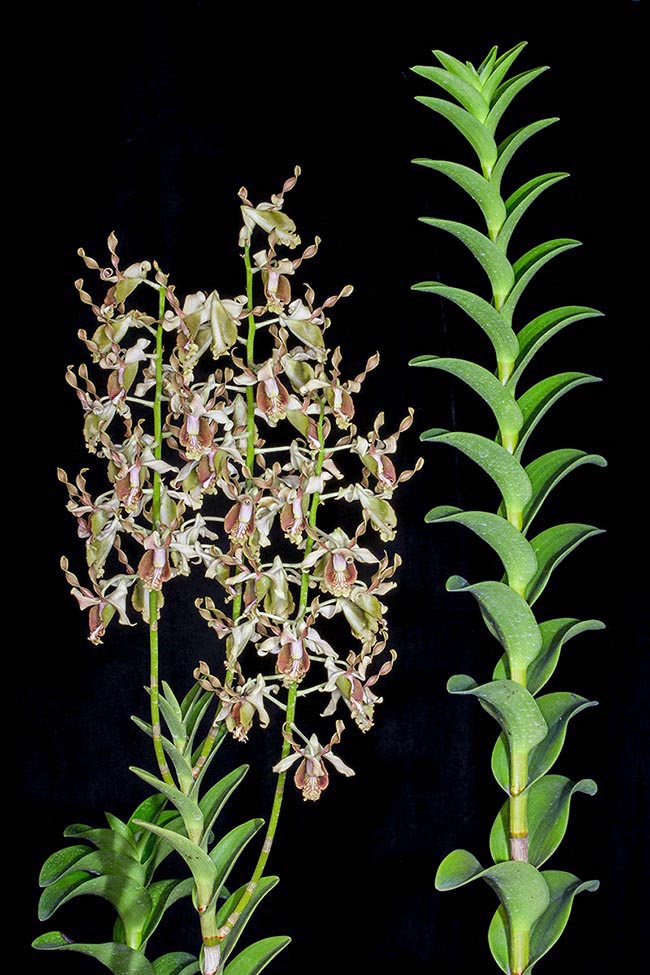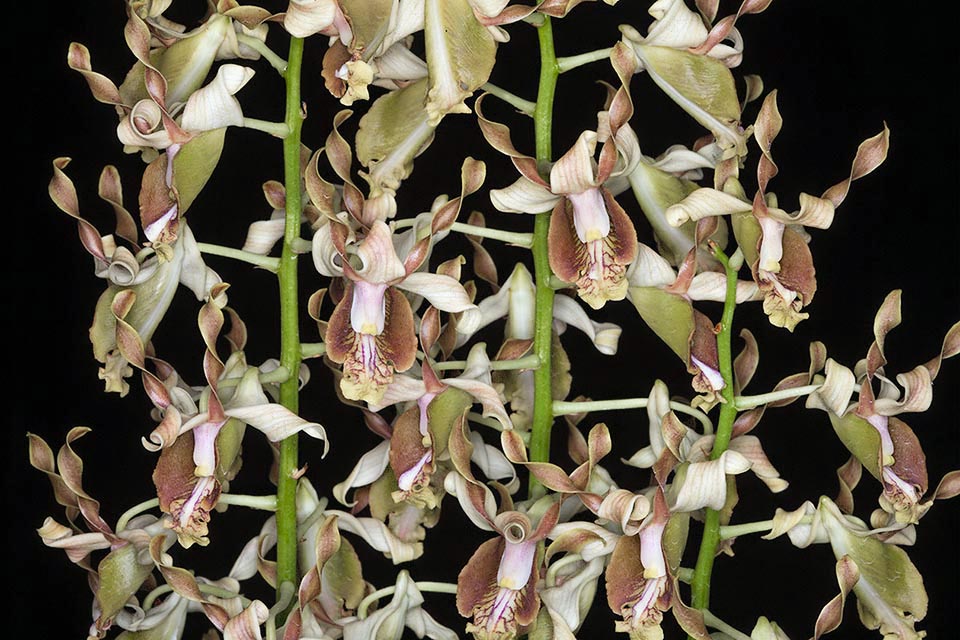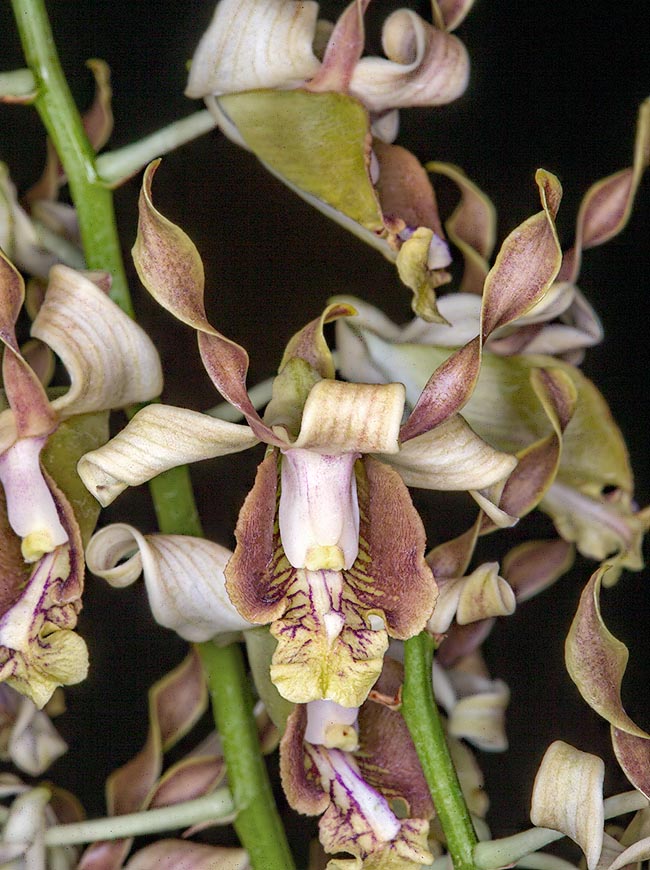Family : Orchidaceae

Text © Prof. Pietro Pavone

English translation by Mario Beltramini
Dendrobium busuangense Ames (1920) is a species of the family Orchidaceae, subfamily Epidendroideae, tribe Malaxideae, subtribe Dendrobiinae, section Spatulata.
This species, found in the island of Busuang (Philippines) at an altitude of about 300 m, was described for the first time by the American botanist Oakes Ames (1874 – 1950) in the publication Orchidaceae 6:296 (1920).
Ames was professor of botany at Harvard University and member of the American Academy of Arts and Sciences. He made expeditions to the Philippines, Central and South America, Florida and Caribbean. His wife, Blanche Ames Ames (1878-1969) worked with him during all her life and being a good drawer, produced with a wealth of details, the plates of the plants he described in his seven volumes publication entitled: Orchidaceae: illustrations and studies of the family Orchidaceae Boston, Houghton, Mifflin, 1905-22.
Dendrobium busuangense is a perennial epiphyte, endemic to the archipelago Calamian (Philippines) that is found in the semi-open woods, mainly of the humid tropical bioma.

Dendrobium busuangense is an epiphyte endemic to Calamian archipelago. Has fusiform pseudobulbs, like canes, up to 2 m long, and with 1 cm of diameter. The usually grouped inflorescences form from the apical nodes © G. Mazza
The name of the genus is the combination of the Greek substantives “δένδρον” (dendron), tree and “βίος” (bios), life, due to the numerous species of the genus living on the trees getting the nourishment from the humid atmosphere, typical to the equatorial forests. The specific epithet refers to the island of Busuang, where it has been found for the first time.
The common name is Busuanga dendrobium.
Dendrobium busuangense presents fusiform pseudobulbs, similar to canes, up to 2 m long, and of 1 cm of diameter. The leaves, of elliptical shape, are coriaceous with evident veins, irregularly bilobate, 7,5 cm long and 4,5 cm broad. The foliar sheaths are tubular, sub-equal or shorter than the internodes.
The inflorescences, usually grouped, form from the apical nodes and present an up to 50 cm long peduncle, with circular section, each one with about 15 flowers. The bracts of the inflorescence are triangular, acute, 3 mm long.
The dorsal sepal is 2,5 cm long and 8 mm broad, oblong-lanceolate, obtuse, with 7 veins.
The lateral sepals are 2,5 cm long, asnate to the foot of the column (4-5 cm long) and to part of the labellum to form an about 1 mm mentum.
The sepams and the mentum are of lavender blue colour.
The petals are 3,5-3,8 cm long and 5 mm broad, erect, oblong, obtuse, twisted, not wavy.
The 3,2 cm long labellum is trilobed, concave, canaliculate below, above with median vein tricostate and with a raised apex. The lateral lobes are subovate with wavy and irregularly toothed margin. The median lobe is oblong, obtuse, about 1 cm long.
The labellum has keels extending on the median lobe, the lateral ones end in tiny rounded protuberances similar to warts. Towards the base and middle of the labellum, the lateral keels are much higher. The median keel is formed by a thickening of the median vein until reaching the median lobe where it ends in an almost 4 mm tall plate.
Usually, the petal and the labellum are greenish, with shades of lavender purple.
The plant blooms in late autumn and in winter and blooming lasts about two months. The seeds are numerous, very small and, in nature, easily dispersed, however as they do not contain reserves, they need, as soon as the rootlet has formed, to unite with fungi in order to form a mycorrhizal association in order to guarantee the right nutritional input for the development of the. new plant.
Dendrobium busuangense has the labellum similar to Dendrobium conanthum Schltr., but the overall look and the posture recall Dendrobium taurinum Lindl. (1843), another member of the section Spatulata of the Philippine islands. The difference with this last species is given by the quite different labellum and the colour of the colours.

They are very ornamental, each one with 15 flowers, and even if it’s not a plant easy to cultivate it has originated various hybrids © Giuseppe Mazza
Recently, in Phytotaxa 528: 270 (2021), has been described as new species Dendrobium dedeksantosoi Metusala, also of the section Spatulata, endemic to the Maluku Islands (Indonesia) whose flower is morphologically very similar to Dendrobium busuangense, but differs as having shorter (2,4-2,6 cm long) oblanceolate petals; the labellum from widely ovate to largely sub-rhomboidal; the median lobe much wider than long, and ratio between the length of the column and of the foot of about 1:1.
Dendrobium busuangense is a species inscribed in the Appendix II of Washington Convention (CITES) that has the purpose of protecting the animal and vegetable species from the risk of extinction, forbidding their export and their detention.
It is also a very ornamental species, particularly delicate, therefore it is necessary to care for it in an adequate way by following correct basic rules.
The low regeneration rate through the cultivation of the seeds is an important limitation for obtaining mass propagation of this species. Usually, it is preferred the multiplication in vitro, the micropropagation or, at amateur level, the division of the tufts. This last operation is to be done by the vegetative regrowth and to guarantee to each section at least 3-4 pseudobulbs.

Close up of a flower with lavender purple shades. The petals are twisted and the labellum is trilobed with keels © Giuseppe Mazza
Dendrobium busuangense is an orchid for being cultivated in a pot of contained size as the roots, very delicate, have a limited development. Repotting is to be done only if necessary and after the blooming.
It is advisable that the pot has holes for drainage and inside on the bottom must be present cork and bark in order to absorb part of the irrigation water, as water stagnation is very dangerous for the roots.
In nature the plant with a temperature included, during the day, between 20 and 29 (32) grades, whilst during the night between 18 and 24 grades. Considering that it is not always easy to get these climate characteristics, the cultivation and the care of the plant is suggested in inner environments, provided full in light like, for instance, the windowsill.
Humidity must be around 70-85% and with a constant movement of air. During the growth period of the pseudobulbs the waterings, with rain or demineralized water, must be regular and abundant, more spaced in winter until the vegetative regrowth. The fertilizations are to be done during the vegetative period with hydrosoluble balanced products, with microelements, at 1/2-1/4 of the dosage suggested on the package for orchids.
Attention is to be paid to the mealybugs that can infest the plant. If they are present, they are to be removed with a cotton swab or an alcohol pad or can be used Neem oil and insecticidal soap.
Various artificial hybrids of Dendrobium busuangense do exist.
Dendrobium Nicha Light Topaz, is a hybrid obtained by Nicha Orchid by crossing between Dendrobium
busuangense × Dendrobium Nicha Natron and registered in 2019 at the Royal Horticultural Society.
Dendrobium Gadjah Mada, obtained by Ali Topan by crossing between Dendrobium busuangense × Dendrobium lasianthera J.J.Sm. and registered in 2019 at the Royal Horticultural Society.
A wonderful hybrid with green yellow flowers and amaranth coloured amaranth is Dendrobium Bhayangkara Emas, obtained by crossing between Dendrobium Bhayangkara Jaya × Dendrobium busuangense by R.S.Nugraha and registered at the Royal Horticultural Society (RHS).
Dendrobium Magenta’s Golden Sunset, obtained by crossing between Dendrobium busuangense × Dendrobium Mem. Loo Sing Chew by R.P.Reitano (Nicha Orchid) and registered in 2022 (RHS). It is an interesting hybrid characterized by flowers with yellow sepals, pink petals and amaranth labellum.
Synonyms: Durabaculum busuangense (Ames) M.A.Clem. & D.L.Jones 2002.
